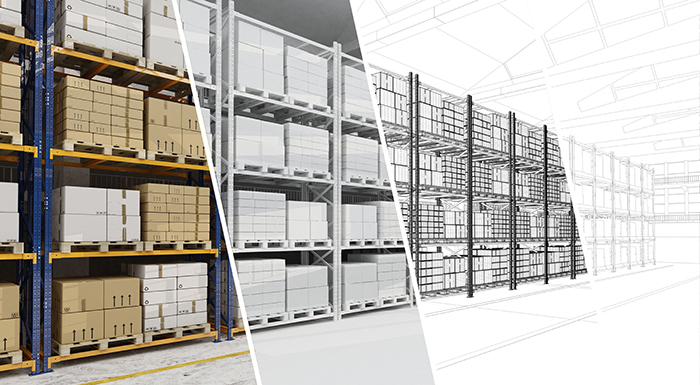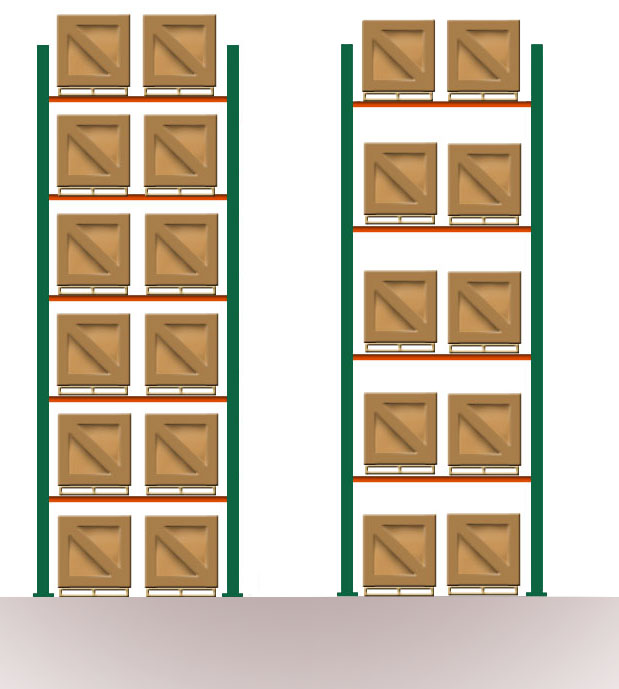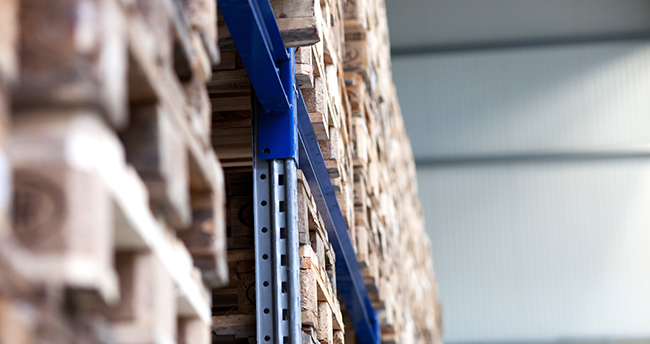How to Safely Modify Your Pallet Racks
A guide to effective rack reconfiguration projects

The nature of pallet racks—adjustable beams and teardrop connections on uprights—invites reconfiguration. Many rack manufacturers’ beams easily connect to other manufacturers’ teardrop uprights, which lets you mix & match components. This versatility can invite trouble if all the factors aren’t considered. Before you adjust beams, add new loads or reconfigure your racks, consider all the factors.
(1) Don’t change vertical beam spacing without doing your homework
 Adding, removing or changing space between beam levels will change upright frame capacity.
Adding, removing or changing space between beam levels will change upright frame capacity.
- Adding beams or reducing space between them typically increases upright capacity. Don’t count on that without a more thorough design examination.
- Removing beam levels usually reduces upright capacity. Remember that rack capacities are based on the height of the largest opening between beams, so changing one changes them all.
If your rack was specified for more than one shelf-level configuration, obtain drawings of any future ways you may want to modify it from your provider. That should include revised capacity ratings, elevations and drawings. This will let you reconfigure beam levels with confidence the rack can do the job you’re asking it to do.
Read more: A Guide To Pallet Rack Load Types
If you plan design revisions that include beam elevations or the layout of a rack system, call the rack provider to discuss your ideas. Inspect all components for damage or wear once a new layout has been determined.
In the image above, since the vertical beam spacing in the rack on the left is tighter than in the one on the right, this bay may be able to handle heavier loads.
(2) Don’t change loads or load types without evaluation
As long as the pallets and loads are within tolerable dimensions and the weight is comparable, you should be able to safely store new loads on an existing pallet rack system.
The problem comes when inventory and the load characteristics change without checking and capacity rating, center of gravity or other factors.
Radically larger, longer or oddly balanced new loads can cause problems if the rack wasn’t engineered to store them. If you’re storing a load of the same size and weight there usually isn’t a problem. Oddly shaped loads with different centers of gravity are a red light.

Above: storing a heavier, smaller load that isn’t deep enough to sit on both the back and front beams changes the forces exerted on the beams. On the left, the full beam supports the load. On the right, with a smaller load, only half the beam (the step ledge) supports the load. This causes a twisting effect that exerts force onto the beam, which causes spread and potentially failure.
Make sure your new load is suitable for your racks. If a new load is longer, bulkier, heavier or unbalanced, check with a professional to be sure you aren’t damaging your beams and potentially causing a failure.
(3) Don’t weld your racks without professional guidance
Welding a stiffener onto a damaged upright will not match the capacity and necessary structural rigidity of the original component. Don’t assume the upright is safer because of it. It probably isn’t.
Repairing a damaged cross member will not restore the upright’s rigidity. There is simply no way to know what the capacity rating of a welded upright might be after the repairs are finished. The welding process itself can cause fire safety issues, as pallets and loads can be flammable.
The good news is that replacement uprights are relatively inexpensive. You can also choose commercially available bolted rack repair kits that will certify the new upright capacity if installed by qualified professionals.

(4) Do your homework with used racks
When it comes to used racks, take care to fully understand both the rack and the application. Some things to consider:
- Simple, non-seismic applications: Used rack is best used for simple storage applications in non-seismic areas.
- Dynamic racks: When the project involves more complications or is long-term, used rack becomes less and less of an option. Most dynamic rack applications should not consider used racks. You should specify new racks for pick modules, pallet flow and other dynamic systems.
- You can’t really know the capacity: Because you can’t know where used racks have been, what loads they have held or abuse they have taken, treat their capacity rating as an estimate. They may have been lightly used in a standard application. They may have been abused and repainted or used outdoors. Always err on the side of caution when determining where you can use these racks or how much they can hold.
- More than meets the eye: Don’t evaluate used rack by looks, since the racks can be refinished to look new.
- Can you identify the components? Make every effort to identify the brand and model numbers involved so you can check the components’ original capacity rating. Models change over time, so knowing what year the rack was manufactured is also helpful.
- Live up to standards: Check RMI (Rack Manufacturers Institute) standards and be sure your used rack meets them. If the used rack lacks capacity plates, can you add them? Can you acquire other documentation for the used components?
- Consider design costs: If you must modify your layout to accommodate used racks, are the savings worth the changes? New racks can be custom fit into your space and process. Used racks require more workarounds and compromises.
What to do when reconfiguring your racks
Assuming you know the rack’s history and usage, take these steps when you need to reconfigure the system:
- Identify the rack manufacturer, model numbers, specification and documentation
- Obtain the original layout and drawings if possible; the best scenario is to have the full history on file
- Work with a rack expert to ensure you have a new plan for the rack system
- Create documentation and drawing with proposed changes
- Inspect the components to ensure they have not been damaged
- Replace or repair damaged components before installing them into new configurations
(5) Mix components with care
Mixing components from various manufacturers and sources can be problematic. RMI recommends that you always match the same components from the same manufacturer to ensure uniformity and safety. Many teardrop rack uprights can accept beams from other manufacturers, but that connectivity can be less robust and less stable. Be sure your rack components are fully compatible with each other. Even when you’re combining newer components with older ones from the same manufacturer, it’s smart to inquire about the way the new rack can differ from your existing racks.
Dimensions and the way they’re calculated can vary between manufacturers. What seems like it should be simple (like an 8-foot beam) may not be consistent between brands and models. Could be a little longer or shorter depending on manufacturing and engineering processes.
The bottom line
You can safely move, add on and redesign your rack system with some common-sense precautions. If you need assistance, contact us today.
Scott Stone is Cisco-Eagle's Vice President of Marketing with 35 years of experience in material handling, warehousing and industrial operations. His work is published in multiple industry journals an websites on a variety of warehousing topics. He writes about automation, warehousing, safety, manufacturing and other areas of concern for industrial operations and those who operate them.



